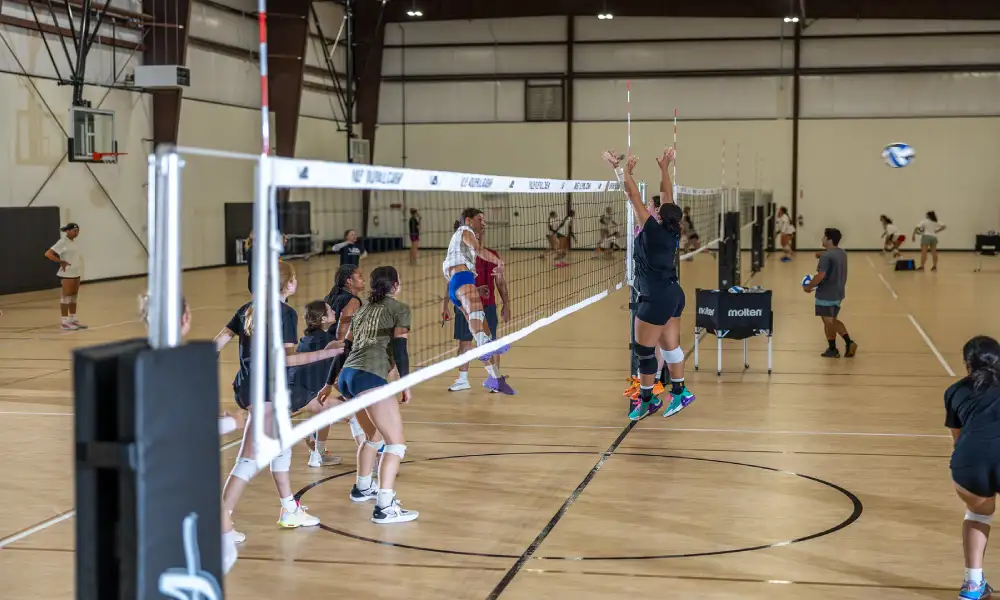Table of Contents
ToggleUnderstanding the 5-1 volleyball rotation is key for running smooth practices, competitive matches, and organized team development. Whether you’re managing a sports facility, renting courts for volleyball leagues, or training athletes, knowing how Volleyball Rotation works can help you support players and coaches more effectively. In this blog, we’ll break down the 5-1 rotation in a clear, simple way, no coaching experience required.
What Is a 5‑1 Volleyball Rotation in Volleyball?
The 5-1 volleyball rotation is a formation in which a team uses one setter and five hitters on the court at all times. The name comes from this split: 5 hitters, 1 setter.
Key Features:
- With the setter in the back row at positions 1, 6, 5, the team has three front-row attackers, usually two outsides and one middle blocker, offering more offensive options
- When the setter rotates to the front row at positions 4, 3, 2, only two front-row attackers remain active. However, the setter becomes an offensive option with plays like setter dumps
Advantages of the 5-1 Rotation in Volleyball
The 5-1 rotation is one of the most widely used offensive systems in volleyball, and for good reason. Whether you’re running a youth league, training athletes, or managing court time for competitive teams, understanding its advantages helps you better support the game. Here’s why many coaches and players prefer the 5-1 setup:
-
-
Consistency
With only one setter on the court at all times, the team builds a steady rhythm. Players get used to the setter’s timing and style, making plays smoother and more predictable. This consistency helps both in practice and during fast-paced games.
-
Coordination
A single setter means everyone knows who’s running the offense. This leads to better team communication and fewer errors, especially in tight game situations. Teams can focus more on positioning and less on switching roles
-
Slide Attack
When the setter is in the back row, three front-row hitters are available. This opens up the chance to run a slide attack, a fast-paced play that keeps blockers guessing and adds variety to the offense. It’s a favorite among middle hitters looking to score quickly.
-
Easier to Learn
Compared to systems like 6-2, which uses two setters, the 5-1 system is simpler for beginners and younger teams to understand. With one main setter, there’s less rotation confusion, especially during transitions between plays
-
Front-Row Setter Options
When the setter rotates to the front row, they can jump and “dump” the ball over the net, acting as a surprise attacker. This keeps defenders on their toes and can lead to quick points. It’s an added offensive tool when used at the right moment.
-
Serve-Receive Rotations
The 5-1 makes serve-receive formations more predictable. Teams can design serve-receive strategies that always involve the same setter placement, reducing miscommunication and helping younger players stay in their zones confidently.
-
Specialized Roles
Since the setter is always the same, other players can specialize in their own roles, like outside hitter, middle blocker, or libero. This lets each athlete develop focused skills, which is great for teams training regularly or preparing for higher-level competition.
-
Disadvantages of the 5-1 Rotation in Volleyball
While the 5-1 rotation is a popular and reliable offensive system, it’s not without its challenges. For facility owners, trainers, and coaches organizing games or practices, knowing the limitations of the 5-1 system helps in better court planning and training support. Here are a few drawbacks teams may face when using this setup:
-
Limited Front-Row Attackers
When the setter rotates to the front row, the team only has two front-row hitters instead of three. This reduces attacking options and can make the offense more predictable. Against strong blockers, this limited setup may lead to fewer scoring chances.
-
Back-Row Passing and Offensive Restrictions
With the setter in the back row, they must cover more ground to get into setting position after a serve receive or dig. If the pass isn’t accurate, it can disrupt the flow of the offense. Plus, since back-row players can’t jump and attack above the net in front of the 10-foot line, some offensive moves are restricted.
-
Setter Workload and Skill Development
In a 5-1 system, the setter is always involved, with no breaks. This puts a lot of pressure on that one player to perform consistently throughout the game. Over time, this can be tiring and may affect decision-making, especially in long matches. Also, if the setter is still developing, it can limit the team’s effectiveness under pressure.
-
Defensive Reliance
Since the focus is on keeping a strong offensive rhythm with one setter, teams may sometimes sacrifice a bit on defense. For example, when the setter plays in the front row, they need to block, something they may not be strong at compared to taller front-row players. This can create weak spots, especially against aggressive opponents.
-
Opponent Adjustments
Experienced teams and coaches can recognize a 5-1 system quickly and adjust their defence accordingly. If they notice limited hitting options in front-row rotations or gaps in blocking, they’ll exploit them. Without variation in offensive plays, the 5-1 setup can become easier to defend over time.
How to Run a 5-1 Volleyball Rotation?
The 5-1 system works by using one setter who runs the offense from any position on the court while the other five players rotate through hitting, passing, and defending roles. This setup keeps the setter on the court the entire game, making the team’s play more consistent and easier to organize.
Here’s a basic breakdown of how it works:
-
- Rotational System: Just like all volleyball systems, players rotate clockwise around the court after winning a rally on the opponent’s serve. As they rotate, each player moves through all six positions, three in the back row and three in the front row.
- Setter Positioning: The setter always sets the ball, no matter where they are on the court. When in the back row, the team has three front-row attackers, giving more offensive power. When the setter moves to the front row, the team plays with two front-row attackers and one setter who can also jump-set or attack, called a “setter dump”.
- Libero and Back Row Roles: The libero typically replaces one of the back-row players (often the middle blocker) to help with serve-receive and defense, allowing the setter to focus on playmaking.
- Setter Transition: After every serve-receive, the setter must quickly move to their ideal setting spot, usually just right of center near the net, no matter where they start the rotation. This makes timing and good passing essential.
This structure helps teams keep a clear offensive leader (the setter) at all times, which is why many competitive teams use it. It also allows facilities and trainers to design drills around a single setter’s movements, making practice more efficient and predictable.
New to rotations? Check out other volleyball rotation strategies.
Strategies for Running a Smooth 5-1 Volleyball Rotation
Running a 5-1 system isn’t just about knowing who stands where; it’s about timing, teamwork, and smart execution. Here are some real-world strategies teams can use to make the 5-1 rotation work like clockwork:
-
Make Setter Transitions Smooth
The setter plays a big role in every play, so it’s important they move quickly from wherever they are, especially when starting in the back row, into their setting position near the net. Good footwork, sharp awareness, and clear signals from teammates help make that transition fast and clean.
-
Define Hitter Roles in Each Rotation
Each hitter needs to know their role depending on where they are in the rotation. For example, sometimes an outside hitter might need to be ready for a back-row attack, or a middle might switch to blocking first. Clear planning and repetition in practice help hitters adjust without missing a beat.
-
Plan Your Blocking Strategy
When the setter is in the back row, your team has three front-row players ready to block. Use that to your advantage by practicing solid block positioning and timing. Decide who goes up against which hitter and how to cover any open spots.
-
Stay Solid on Defense
Defense starts with the back row being ready for anything, tips, roll shots, or hard hits. Everyone needs to know their zone and talk constantly. The front and back rows must work together so nothing drops in the middle.
-
Prioritize Serving and Serve Receive
A tough serve can throw off the other team’s rhythm fast. On the flip side, when your team is receiving, a clean pass is key to getting the ball to your setter. Make 5 1 volleyball rotation serve receive formations clear and consistent, so players know exactly where to go.
-
Keep Talking, Communication is Everything
In a 5-1, one mistake can shift the whole rhythm of a play. That’s why players need to talk before the serve, during the rally, and after the point. Whether it’s calling for the ball, helping the setter, or switching positions, good communication makes the system work.
Final Thoughts
The 5-1 rotation for volleyball is a smart, efficient system that offers structure, consistency, and strategic depth, whether you’re coaching a team, running a training session, or managing a facility that hosts competitive games. By understanding how it works and supporting teams with the right setup, drills, and communication, you help players grow, improve, and play their best. Whether it’s youth leagues or advanced clubs, the 5-1 system is a go-to for a reason, and knowing the ins and outs is a win for everyone involved.
Curious about volleyball rotation strategies? Learn them and more by joining our Volleyball Programs today!
FAQ’s About the 5-1 Rotation Volleyball
Q: Can you run a fast offense with a 5-1 setup?
Yes, you can! Even though there’s only one setter, a quick offense is totally possible, especially if the setter has good timing and chemistry with the hitters. Quick sets and fast plays are definitely on the table with this system.
Q: Where does a 5-1 rotation setter usually start?
It can vary, but most teams like to start their setter in the back-right corner (also known as Zone 1). This makes it easier for them to move into position near the net to set up plays right away.
Q: How do substitutions work in a 5-1 system?
Substitutions depend on the rules of the league you’re playing in. Generally, players can be subbed in and out, but teams need to follow set rules on how often and who replaces whom. The most important thing? Keep the rotation order intact!
Q: Is the 5-1 a good system for all skill levels?
The 5-1 is popular in high school, college, and pro-level volleyball because of how much control it gives the setter. For younger or newer teams, though, a 6-2 system might be easier to learn since it gives more players a chance to try setting.
Q: How do you train players to run a 5-1 system well?
Practice, practice, and more practice! Focus on things like setter movement, timing with hitters, h3 blocking, solid defense, and clear team communication. Running drills that mimic real-game situations really helps players get comfortable with their roles.
Q: Can the setter score points in a 5-1?
Absolutely! When the setter rotates to the front row, they’re allowed to jump and push the ball over on the second contact, a move often called a “setter dump.” It can catch the defence off guard and score surprise points.
Q: What do you do if the first pass isn’t perfect?
That’s where the setter’s skills really shine. They need to be ready to chase down the ball and set from wherever they can. It’s also smart to have a backup player ready to step in if the setter can’t reach the ball.
Q: What should beginners focus on when learning the 5-1 rotation?
Start with the basics, learn how the rotation works, understand what the setter’s job is, and practice good communication. Getting comfortable with moving into position and working together as a team is key.
Authors
-
Sarah Baker is a dedicated sports and fitness content specialist with a rich background in athletics. As a former high school volleyball player and track athlete, she understands the transformative power of sports in shaping character and fostering discipline. Sarah is passionate about inspiring youth worldwide to embrace sports, hone their skills, and achieve excellence both on and off the court. She continually expands her knowledge through ongoing education in sports performance and fitness, aiming to empower her audience with valuable insights. Currently, Sarah contributes her expertise to the content team at Valley Athletics, a premier sports facility in Fresno, California, dedicated to developing young athletes in volleyball, basketball, and pickleball.
View all posts -

Jonathan stands as a monumental figure in volleyball, boasting accolades such as National Champion, National Player of the Year, and being one of the select few, just thirteen, to achieve All-American status four times in NCAA volleyball history. His illustrious playing journey took flight at Pepperdine University, culminating in his 2005 NCAA Championship win, AVCA National Player of the Year and Newcomer of the Year titles.
View all posts



